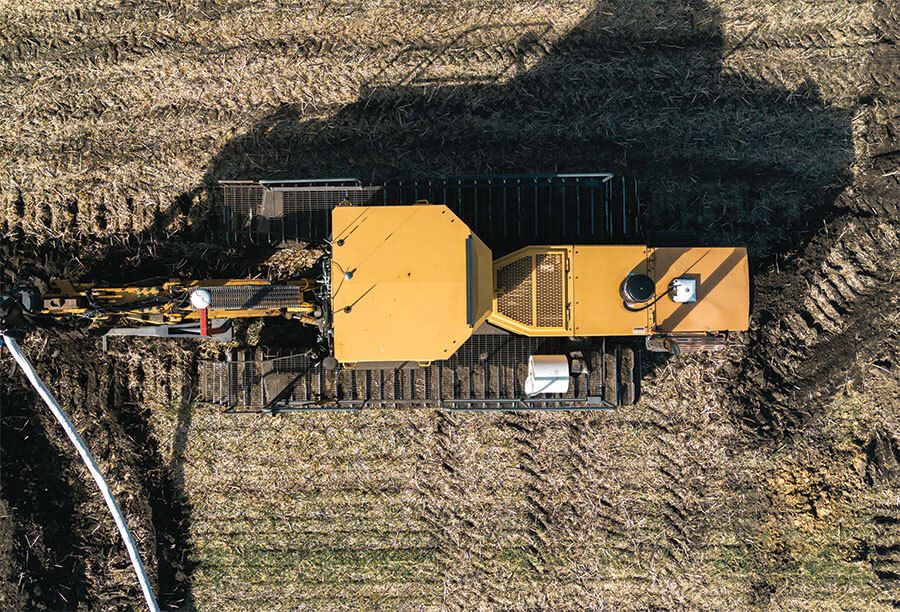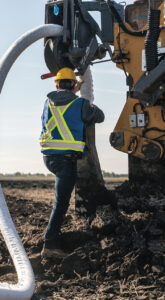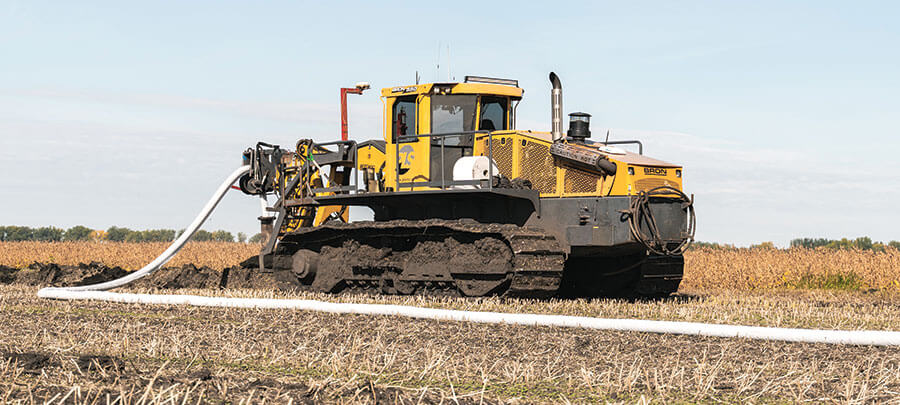Tile drainage – a foundational investment
Recently I had the opportunity to speak with farmer Don Wiebe of Beaver Creek Farms, a family farm near MacGregor, Manitoba. Don has been farming with his brother Stan since 1968 and together they grow several crops, including canola, wheat, corn, soybeans and potatoes for the french fry market. They have a team of 12 full-time employees and are currently transitioning to the next generation.
After listening to a presentation from Chris Unrau and Frank Elias from Precision Land Solutions about some of the tile drainage work they have been doing with growers, I reached out to Don at Beaver Creek Farms to dig a little deeper into his on-farm experience with tile drainage and what it has meant to their farming operation.
One of the first things Don mentioned to me was that his brother Stan was interviewed for an article about tile drainage in County Guide magazine in 2005. When asked about the benefits of tile, Stan said at that time that canola on tiled land yielded 50 bu./ac. while canola on untiled land yielded six bu./ac. because it had drowned out.
Back in the late 1990s, the Wiebes started watching neighbours and another farm near Winkler who had installed tile on some potato ground. They were impressed. Tile drainage helped those neighbours deal with the struggles of excess moisture on potato land. When potato processors mandated irrigation in the contracts, the Wiebes started installing tile before installing the irrigation. It improved the productivity and profitability of their Almasippi sand.
The Wiebes have weather records for a lot of years and 2022 was their wettest growing season on record. This was too much water – even for some tile-drained land. I asked Don about tile-drained land in dry years. It doesn’t hurt them on a dry year, it only drains water the soil can’t hold, he says.
When Beaver Creek Farms started installing tile drainage in the late 1990s, they didn’t have a lot of local options, so they hired a contractor out of Thorndale, Ontario. Plastic tile drainage pipe also had to be trucked in from Ontario. Manitoba now has its own installation contractors and pipe manufacturing companies.
Beaver Creek Farms has tiled 300-500 acres per year over the past 20-plus years, including some long-term rental land. They have another 400 acres to go and then will have everything tiled.
“A foundational investment”
Investing $1,000 to $1,400 per acre for tile drainage will not be in the budget for a lot of farms, but the benefits are long term. On Beaver Creek Farms, the first tile installed over 25 years ago is still in excellent condition and working as well as it did on day one, Don says.
Tile drainage is a “foundational investment,” Don says. It’s nothing glamorous like buying a new combine, but it helps set up the next generation for success. Don lists the benefits:
- Risk management. Like insurance or irrigation, tile drainage is a risk management investment that doesn’t have to make money every year.
- Tile drainage just lets them farm. After a rain stops field operations, tiled fields are ready to go quickly. With untiled fields, there is uncertainty when you can get back on them.
- It makes life easier.
- Tiled land helps Don sleep better when he knows there is more rain coming.
I asked Don how much more tile drained land was worth in his area compared to untiled land. He doesn’t really know because he hasn’t seen any local tiled land go up for sale. Farms installing tile drainage aren’t into selling land, he says.

Hurdles and advice
I asked Don about hurdles they had to get over when starting to do tile drainage. Basically the biggest thing that helped, he says, was to educate neighbours and the community about how tile works. They also had to understand the infrastructure required to make the system work properly with good outlets and a place for the water to go.
Beaver Creek Farms has learned a few things about system design and how to do things differently. This includes installation of more electric lift stations to help get the water to where it needs to go and making sure sprayer operators are careful when driving on newly tiled fields.
I asked Don what advice he would give someone thinking about tile drainage. He listed some things he has learned:
- Start with a reputable tile contractor and stick with them. That relationship is invaluable. You don’t want to be at the bottom of the list when installation season starts.
- Start small and prove it to yourself.
- Start now. Don is glad they started early as it has given them a career of farming on tiled land.
- Pick a field that needs it. Fields that already have good drainage don’t show the contrast.
- You can start to fix saline soil, but it is very slow and you need a pile of water to flush the salt out.
- Tile drainage works because it follows a fundamental physics principle.
For more on tile drainage, find the factsheet “Beneficial management practices for agricultural trial drainage in Manitoba” at pami.ca, and “Agricultural water management – Drainage approvals” at wsask.ca.
Beaver Creek Farms are, for the most part, do-it-yourself people but they appreciate the expertise that a professional contractor can bring to the job. “A poor tile drainage installation is worse than no tile at all,” Don says. He recommends a farmer be on site during installation and to have operators show what they’re doing and explain the process. Contractors with a good reputation and professional business can get the permits required and do proper job design that works the way it is supposed to.

I asked Don what some of the myths about tile drainage. One of the biggest myths, he says, is that tile drainage fixes everything. With so much water in 2022, they experienced some crop loss on a few tiled fields. Their tile drainage system at 50 foot spacing and a 0.25 inch drainage coefficient might not be enough for some fields or some parts of fields, he says. Tile doesn’t prevent overland flooding. Beaver Creek Farms still does some surface ditching, which helps keep the infrastructure maintained and working properly.
Beaver Creek Farms has seen the soil health benefits from tile drainage and how communities can grow when farms are healthy and able to support the economy with employment and opportunities. Investment in tile drainage might not win for you every year, Don says, but it will give you a chance, a better chance, to get a better crop.
My conversation with Don Wiebe helped me understand their goal to tile drain as much of their land as they could. Tile drainage is part of their overall plan of “foundational investment” in the health of the land. Land is the primary asset for a farm, for the short term and the long term.





